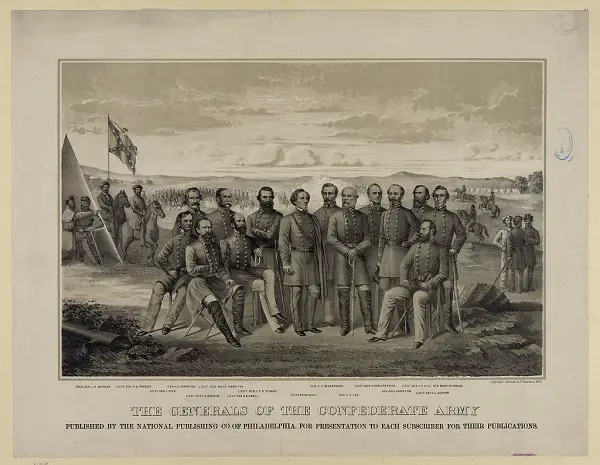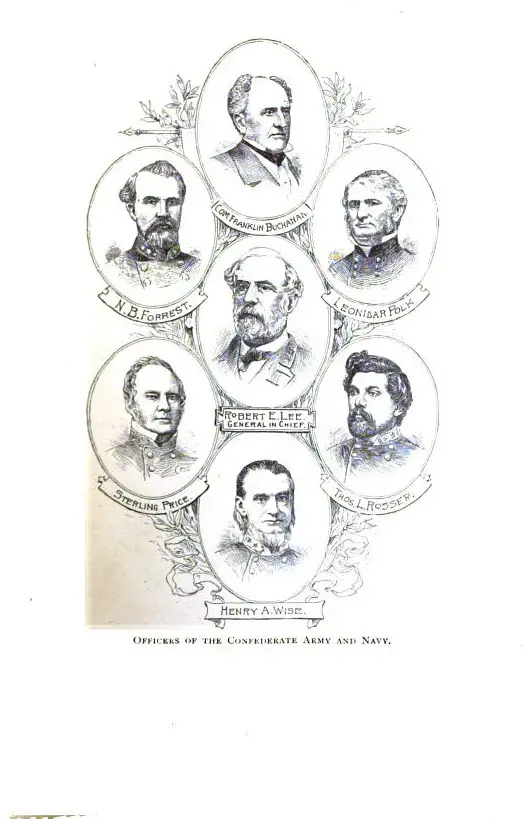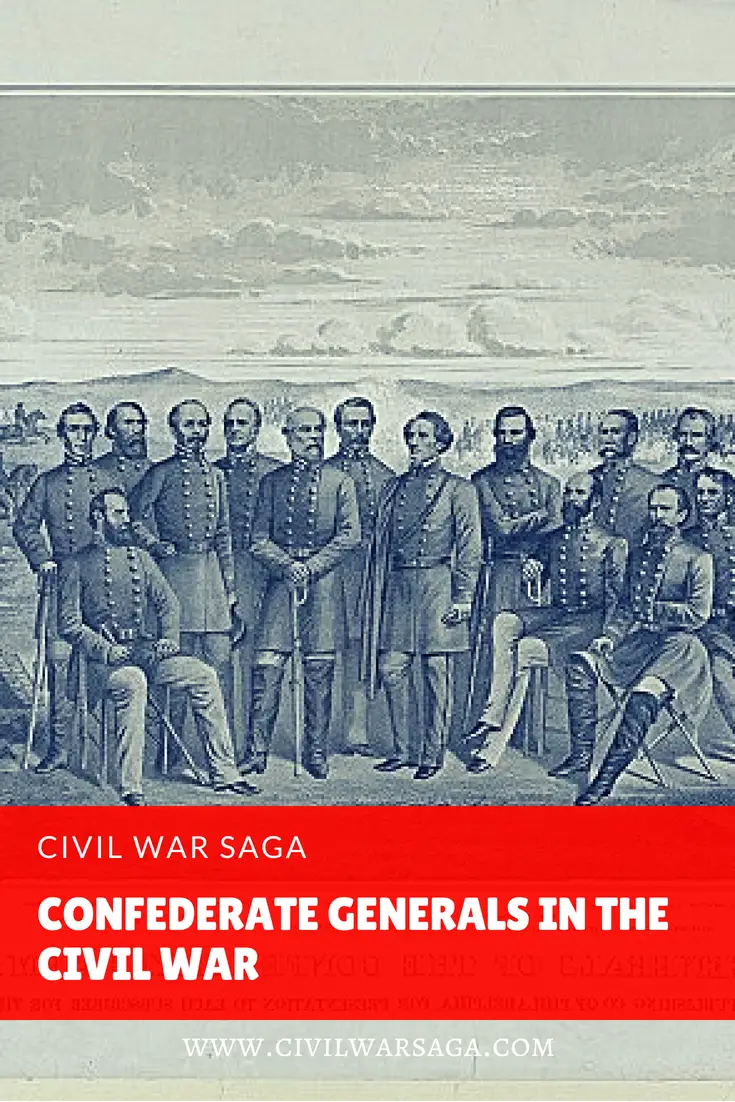Confederate generals served in the Confederate States Army on behalf of the Confederate States of America.
Although the majority of these generals were from the south, a handful of them were also from the north.
These generals were often military professionals who were trained at military academies like West Point. A number of them were also generals in the United States Army when the Civil War broke out and resigned in order to join the Confederacy.

The Generals of the Confederate Army, illustration, circa 1879
The following are some facts about Confederate generals in the Civil War:
How Many Confederate Generals Were in the Civil War?
There were approximately 425 Confederate generals in the Civil War (Warner xix).
How Many Confederate Generals Were Killed in the Civil War?
A total of 73 Confederate generals were killed or mortally wounded in battle during the Civil War, according to William F. Fox in his book Regimental Losses in the American Civil War, 1861-1865 (571-572).
Yet, Ezra J. Warner states in his book, Generals in Gray, that 77 generals were killed in battle (Warner xix).
Warner also states that an additional 15 Confederate generals died by accident or from natural causes, two were killed in “personal encounters” (duels), one was assassinated and one committed suicide.
Confederate Generals Killed in the Civil War:
The following is a list of Confederate generals who were either killed or mortally wounded in battle during the Civil War (Fox 571-572):
Army Commanders:
General Albert Sydney Johnson – Killed at Shiloh
Corps Commanders:
Lieutenant-General Thomas A. Jackson – Mortally Wounded at Chancellorsville by friendly fire
Lieutenant-General Leonidas Polk – Killed at Pine Mountain
Lieutenant-General Ambrose P. Hill – Killed during the Fall of Petersburg
Division Commanders:
Major-General William D. Pender – Mortally Wounded at Gettysburg
Major-General J.E.B. Stewart – Mortally Wounded at Yellow Tavern
Major-General W.H. Walker – Killed at Atlanta
Major-General Robert E. Rodes – Killed at Opequon
Major-General Stephen D. Ramseur – Mortally Wounded at Cedar Creek
Major-General Patrick R. Cleburne – Killed at Franklin
Brigadier-General John Pegram – Killed at Hatcher’s Run
Brigade Commanders:
Brigadier-General Robert S. Garnett – Killed at Cheat Mountain
Brigadier-General Bernard E. Bee – Killed at First Bull Run
Brigadier-General Francis S. Bartow – Killed at First Bull Run
Brigadier-General Felix K. Zollicoffer – Killed at First Bull Run
Brigadier-General Ben McCulloch – Killed at Pea Ridge
Brigadier-General James McIntosh – Killed at Pea Ridge
Brigadier-General William Y. Slack – Mortally Wounded at Pea Ridge
Brigadier-General Adley H. Gladden – Mortally Wounded at Shiloh
Brigadier-General Robert Hatton – Killed at Fair Oaks
Brigadier-General Turner Ashby – Killed at Harrisonburg
Brigadier-General Richard Griffith – Mortally Wounded at Savage Station
Brigadier-General Charles S. Winder – Killed at Cedar Mountain
Brigadier-General Samuel Garland, Jr – Killed at South Mountain
Brigadier-General George B. Anderson – Mortally Wounded at Antietam
Brigadier-General L. O’B. Branch – Killed at Antietam
Brigadier-General William E. Starke – Killed at Antietam
Brigadier-General Henry Little – Killed at Iuka
Brigadier-General Thomas R. Cobb – Killed at Fredericksburg
Brigadier-General Maxey Gregg – Killed at Fredericksburg
Brigadier-General James E. Rains – Killed at Stone’s River
Brigadier-General Roger W. Hanson – Killed at Stone’s River
Brigadier-General E.D. Tracy – Killed at Port Gibson
Brigadier-General E.F. Paxton – Killed at Chancellorsville
Brigadier-General Lloyd Tilghman – Killed at Champion’s Hill
Brigadier-General Martin E. Green – Killed at Vicksburg
Brigadier-General William Barksdale – Killed at Gettysburg
Brigadier-General Lewis Armistead – Killed at Gettysburg
Brigadier-General Richard B. Garnett – Killed at Gettysburg
Brigadier-General Paul J. Semmes – Mortally Wounded at Gettysburg
Brigadier-General J.J. Pettigrew – Mortally Wounded at Falling Waters
Brigadier-General Preston Smith – Killed at Chickamauga
Brigadier-General Benjamin H. Helm – Mortally Wounded at Chickamauga
Brigadier-General James Deshler – Killed at Chickamauga
Brigadier-General Carnot Posey – Mortally Wounded at Bristoe Station
Brigadier-General Alfred Mouton – Killed at Sabine Cross Roads
Brigadier-General Thomas Green – Killed at Pleasant Hill
Brigadier-General W. R. Scurry – Killed at Jenkins Ferry
Brigadier-General John M. Jones – Killed at Wilderness
Brigadier-General Micah Jenkins – Killed at Wilderness
Brigadier-General L.A. Stafford – Killed at Wilderness
Brigadier-General Abner Perrin – Killed at Spotsylvania
Brigadier-General Julius Daniel – Killed at Spotsylvania
Brigadier-General James B Gordon – Killed at Yellow Tavern
Brigadier-General George Doles – Killed at Bethesda Church
Brigadier-General W. E. Jones – Killed at Piedmont
Brigadier-General C.H. Stevens – Killed at Peach Tree Creek
Brigadier-General Samuel Benton – Ezra Church
Brigadier-General John R. Chambliss, Jr – Killed at Deep Bottom
Brigadier-General J.C. Saunders – Killed at Weldon Railroad
Brigadier-General Robert H. Anderson – Killed at Jonesboro
Brigadier-General John Morgan – Killed at Greenville, Tenn
Brigadier-General Archibald C. Godwin – Killed at Opequon
Brigadier-General John Dunnovant – Killed at Vaughn Road
Brigadier-General John Gregg – Killed at Darbytown Road
Brigadier-General Stephen Elliot, Jr – Mortally Wounded at Petersburg
Brigadier-General Victor J. Girardey – Killed at Petersburg
Brigadier-General Archibald Gracie, Jr – Killed at Petersburg Trenches
Brigadier-General John Adams – Killed at Franklin
Brigadier-General Oscar F. Stahl – Killed at Franklin
Brigadier-General S.R. Gist – Killed at Franklin
Brigadier-General H.B. Granberry – Killed at Franklin
Brigadier-General James Dearing – Killed at High Bridge
Were Confederate Generals Pardoned?
Both President Abraham Lincoln and President Andrew Johnson issued a series of proclamations that pardoned the confederates but Confederate military leaders, government officials and many others were excluded from the earlier proclamations and weren’t pardoned until 1867.

Officers of Confederate Army and Navy, illustration published in the Short History of Confederacy circa 1890
On December 8, 1863, President Lincoln issued Proclamation 108 which was a Proclamation of Amnesty and Reconstruction that granted a full pardon and restoration of property to all “persons who have, directly or by implication, participated in the existing rebellion” except for the highest Confederate officials and military leaders:
“The persons excepted from the benefits of the foregoing provisions are all who are, or shall have been, civil or diplomatic officers or agents of the so-called Confederate government; all who have left judicial stations under the United States to aid the rebellion; all who are, or shall have been, military or naval officers of said so-called Confederate government above the rank of colonel in the army or of lieutenant in the navy; all who left seats in the United States congress to aid the rebellion; all who resigned commissions in the army or navy of the United States and afterwards aided the rebellion; and all who have engaged in any way in treating colored persons, or white persons in charge of such, otherwise than lawfully as prisoners of war, and which persons may have been found in the United States service as soldiers, seamen, or in any other capacity.”
On March 26, 1864, President Lincoln issued Proclamation 111 which clarified that the proclamation of December 8, 1863 only applied to persons who were not in military, civil or naval confinement or custody at the time.
On May 29, 1865, President Andrew Johnson issued Proclamation 134 which granted a full pardon and restoration of all rights to participants in the rebellion but again excluded Confederate military leaders above the rank of colonel and Confederate military and naval officers who were educated by the government at West Point Academy or the United States Naval Academy.
On September 7, 1867, President Andrew Johnson issued Proclamation 167 which modified the May 29, 1865 proclamation to include “all persons who, directly or indirectly, participated in the late rebellion, with the restoration of all privileges, immunities, and rights of property…” This proclamation officially pardoned Confederate military leaders and others who had been previously excluded.
On July 4, 1868, President Andrew Johnson issued Proclamation 170 which granted a full pardon and amnesty for the charge of treason to “every person who, directly or indirectly, participated in the late insurrection or rebellion” except for people currently under indictment for the charge.
On January 9, 1867, President Johnson sent Congress a list of high level former Confederates for whom he had issued pardons. The Nashville Telegraph and Union published a partial list of these names on January 13, 1867. The following are the names of Confederate generals from that list:
Bradley T. Johnson, brigadier general
George H. Steuart, major general
Edward Johnson, general
James L. Kemper, major general
E.G. Lee, brigadier general
P.T. Moore, brigadier general
R.L. Page, brigadier general
J.M. St. John, brigadier general
John Echols, brigadier general
Alexander C. Jones, brigadier general
R. Barringer, brigadier general
William R. Cox, brigadier general
Bryan Grimes, brigadier general
Bradley T. Johnson, brigadier general
M.W. Ransom, brigadier general
A.M. Seales, brigadier general
W.L. Bonham, brigadier general
M. Butler, brigadier general
John Bratton, brigadier general
Stephen Elliott, Jr., brigadier general
Walter Gwynn, brigadier general
John Hagood, brigadier general
G.S. Preston, brigadier general
L.G. Gartrell, brigadier general
H.R. Jackson, brigadier general
L. McLaws, graduate of West Point, brigadier general
J.P. Anderson, major general
W.G.M. Davis, major general
J.S. Finley, brigadier general
C.A. Battle, brigadier general
Alpheus Baker, brigadier general
F.M. Cockerill, brigadier general
H.D. Clayton, major general
Z.C. Deas, brigadier general
Duff C. Green, brigadier general
J.T. Holtzclaw, brigadier general
John T. Morgan, brigadier general
Y.M. Moody, brigadier general
E.W. Pettus, brigadier general
P.D. Roddy, brigadier general
S.A.M. Wood, brigadier general
S.R. Anderson, major general
A.E. Jackson, brigadier general
Geo. Maney, brigadier general
J.B. Palmer, brigadier general
Gideon J. Pillow, brigadier general
J.R.C. Lewis, colonel
Charles E. Thorburne, colonel
Richard B. Lee, lieutenant colonel
On December 25, 1868, President Andrew Johnson issued Proclamation 179 which was a final proclamation granting full pardon and amnesty for the offense of treason “to every person who, directly or indirectly, participated in the late insurrection or rebellion.”
Sources:
Southern Historical Society Papers. Vol XXX, Edited by R.A. Brock, Southern Historical Society, 1902.
“Proclamation of Amnesty and Reconstruction, December 8, 1863.” Freedman & Southern Society Project, www.freedmen.umd.edu/procamn.htm
Warner, Ezra J. Generals in Gray: Lives of the Confederate Commanders. Louisiana State University Press, 2006.
Phisterer, Frederick. Statistical Record Of The Armies Of The United States. New York: Charles Scribner’s Sons, 1883.
Fox, William F. Regimental Losses in the American Civil War, 1861-1865. Albany Publishing Co, 1889.


thank for put a good web site on.
Great info. I have been a civil war buff since high school. Info will be added to my collection of civil war days.
A great resource. Many thanks.